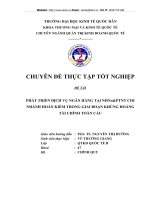Đoàn văn hoàng 19071041 SOC1050
Bạn đang xem bản rút gọn của tài liệu. Xem và tải ngay bản đầy đủ của tài liệu tại đây (57.29 KB, 6 trang )
BỘ GIÁO DỤC VÀ ĐÀO TẠO
TRƯỜNG QUỐC TẾ - ĐẠI HỌC QUỐC GIA HÀ NỘI
ESSAY
Threads : How do people respond to cultural differences in
communication? Give appropriate examples.
Instructors : Vũ Xuân Đoàn
Student's first and last name : Đoàn Văn
Hoàng
Student ID: 19071041
CourseCode: SOC1050
1
CourseTitle: General Sociology
Threads : How do people respond to cultural differences in
communication? Give appropriate examples.
Essay :
We live in a diverse and extremely developed world. In which
people are increasingly moving between countries and cultures.
International students often want to study in developed
countries such as the US, Australia, Canada because they have
a more developed education than other countries. To participate
effectively
in
today's
world,
we
must
recognize
that
communication is deeply related to culture. Being effective in
social and professional life requires you to understand and
adapt your communication with people of different cultures.
Communication
is
closely
linked
to
culture
because
communication expresses, sustains, and alters culture. Your
culture directly shapes how you communicate, teaching you
whether and when interrupting is appropriate, how much eye
contact is polite, and how much distance should be kept
between people. We are not born knowing how, when, and to
whom to speak, just as we are not born with attitudes about
cooperating or competing. We acquire attitudes as we interact
with others, and we then reflect cultural teachings in the way
we communicate. Although the word culture is part of our
everyday vocabulary, it’s diffi cult to defi ne. Culture is part of
everything we think, do, feel, and believe, yet we can’t point to
2
a thing that is culture. Most simply defi ned, culture is a way of
life a system of ideas, values, beliefs, customs, and language
that is passed from one generation to the next and that
sustains a particular way of life.
One of the best indicators that a culture or social community
exists is communication. Because we learn to communicate in
the process of interacting with others, people from different
cultures use communication in different ways and attach
different
meanings
to
communicative
acts.
Research
by
intercultural communication scholars shows that one way to
distinguish cultures is by the extent to which they value
individualism or collectivism Individualistic cultures regard each
person as distinct from other people, groups, and organizations.
Individualistic cultures value personal freedom, individual
rights, and independence. Communication in individualistic
cultures
tends
to
be
assertive
and
often
competitive.
Collectivist cultures regard people as deeply connected to one
another and to their families, groups, and communities.
Collectivist cultures value intergroup order and harmony, group
welfare, and interdependence . Within collectivist cultures,
communication tends to be other-oriented and cooperative, and
collective accomplishments are more valued than personal
ones. Cultural rituals and roles tend to celebrate communal
achievements
more
than
individual
ones.
Responses
to
diversity range from total rejection to full participation in a
different culture’s communication styles. At particular times in
our lives, we may fi nd ourselves adopting different responses
to diversity or to specifi c forms of diversity.
3
First, That first reaction is resistance . A common response to
diversity is resistance, which occurs when we reject the beliefs
of particular cultures or social communities. Resistance denies
the value and validity of particular cultural styles. Without
reflection, many people evaluate others based on the standards
of their own culture. For example, resistance may be expressed
in many ways. Hate crimes pollute campuses and the broader
society. Denial of other cultures leads to racial slurs, antiSemitic messages, and homophobic attacks.
A second response to cultural differences in communication
is tolerance, which is an acceptance of differences whether or
not one approves of or even understands them. Tolerance
involves respecting others’ rights to their ways even though we
may think their ways are wrong, bad, or offensive. Judgment
still exists, but it’s not actively imposed on others. Tolerance is
open-mindedness in accepting the existence of differences, yet
it is less open-minded in perceiving the value of alternative
lifestyles and values.
Third response to cultural differences in communication is
understand, which is understanding that differences are rooted
in cultural teachings and that no cultural teachings are
intrinsically best or right. This response builds on the idea of
cultural relativism. Rather than assuming that whatever differs
from our ways is a deviation from a universal standard, a
person who understands realizes that diverse values, beliefs,
norms, and communication styles are rooted in distinct cultural
perspectives. For example, People who respond to cultural
differences in communication with understanding might notice
4
that a Japanese person doesn’t hold eye contact but would not
assume that the Japanese person was devious. Instead, an
understanding person would try to learn what eye contact
means in Japanese society in order to understand the behavior
in its native cultural context. Curiosity, rather than judgment,
dominates in this stage, as we make active efforts to
understand others in terms of the values and traditions of their
cultures.
Respect - Once we move beyond judgment and begin to
understand the cultural basis for ways that differ from ours, we
may come to respect differences. We can appreciate the
distinct validity and value of placing family above self, of
arranged
marriage,
and
of
feminine
and
masculine
communication styles. We don’t have to adopt others’ ways in
order to respect them on their terms.
A final response to diversity is participation, in which I
incorporate some practices and values of other groups into our
own lives. More than other responses, participation encourages
us to develop skills for participating in a multicultural world in
which all of us can take part in some of each other’s customs.
For example, People who respond to diversity by participating
learn to be multilingual, which means they are able to speak
and understand more than one language or more than one
group’s ways of using language. Many people are already at
least bilingual
Developing skill in intercultural communication takes time.
We don’t move suddenly from being unaware of how people in
other cultures interact to being totally comfortable and
5
competent in communication with them. Adapting to cultural
diversity is a gradual process that takes time, experience with a
variety of people, and a genuine desire to know and appreciate
cultural differences.
6









